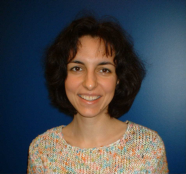Magnesium Diboride (MgB2) thin films and Josephson devices
Promotion date: 3 June 2004
| Magnesium Diboride is a material that has been synthesized in the fifties, but its superconducting properties were announced for the first time in January 2001. Superconductivity means that below a certain temperature a current can be conducted through some material without any resistance. This superconductor can operate at a temperature of 39 Kelvin (about -240C), which means that you can use much smaller coolers with less input power. |
What is your thesis about?
Magnesium Diboride is a material that has been synthesized in the fifties, but its superconducting properties were announced for the first time in January 2001. Superconductivity means that below a certain temperature a current can be conducted through some material without any resistance. This superconductor can operate at a temperature of 39 Kelvin (about -240C), which means that you can use much smaller coolers with less input power. It is also a relatively uncomplicated and inexpensive compound. Josephson devices (or Squids- Superconducting Quantum Inference Devices) that we structured in MgB2 thin films showed a rather high sensitivity. Therefore this compound holds the promise of biomedical applications like measuring foetal heartbeat for instance, which is important in the research of cot death (irregularities in foetal heart rhythm are suspected to be a possible cause). But it is mainly fundamental research, with a little eye to practical applications.
In order to get a working device it needs cooling. How do you cool your device to such a low temperature?
By applying liquid Helium in our experiments, this is a standard technique nowadays.
So the new thing you found is that MgB2 makes an excellent superconductor.
No, that was discovered in January 2001, but as a result all kind of groups all over the world started to work with this material for a better understanding of it. Our group had a close collaboration with the PennState group in the US.
At first we had difficulties here getting the right films: magnesium is extremely volatile and magnesium and boron can easily form oxides and if you want to grow nice films you need enough magnesium, reduced amount of the residual oxygen in the deposition chamber and deposition at very high temperatures (~600-7000C). The latter presents a problem since the probability of Mg to stick into the film above 3000C is very low. We used Pulsed Laser Deposition (PLD) working in a vacuum. We managed to make superconducting films but we got up to 30K superconductivity, we could not get it to 39 K . In PennState University they used adapted chemical vapour deposition (HPCVD), which is not a vacuum technique resulting in a superconductivity of 39K, and very smooth films.
So that group in the US really helped you along?
Yes, it was a very good and close collaboration. They helped us and we at Mesa and Low Temperature Division helped them forming devices in their films and investigating the device properties. Now we are working on a paper to be published together. The differences in their and our films have really given a better understanding of the fundamental properties of MgB2.
Have you been to the US a lot during your research?
No, in fact only once, because for structuring we have a lot of expertise here.
You are from Serbia, how did you get here?
I did my Master Degree here on an international programme for foreign students and then they offered me this PhD.
Do you like it here?
Yes, very much. I love the group and the facilities and the possibilities that are offered to you, the opportunity to travel and meet others. When I compare it to other groups in the world it is really great. Apparently here they have a nice policy with regard to PhD’s. They want us to build our own networks and establish our own collaborations.
I have noticed that Twente, the Low Temperature Division and Mesa are well known.
At the conferences, especially at very large ones like European Conference on Applied Superconductivity (EUCAS) lots of people come to our poster presentation, exchanging information and cards, and I noticed that they are very interested in what we are doing. We get an amazing amount of opportunities.
What are you going to do next?
I am hoping for a postdoc here in Twente, in a different group. Because of all the multi disciplinary directions like environmental science and biophysics requiring chemical, physical and biological knowledge, physicists need a broad overview and it is not unusual to change the field of their research every 4 or 5 years.

